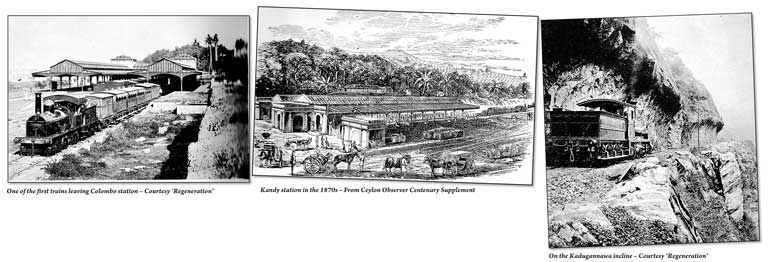Sunday Dec 15, 2024
Sunday Dec 15, 2024
Saturday, 5 August 2017 00:47 - - {{hitsCtrl.values.hits}}
 By D.C. Ranatunga
By D.C. Ranatunga
As the first week of August this year marks a milestone in the history of the Railway in Sri Lanka, I am reminded of how people identified the new mode of transport with a catchy verse: Anguru kaka watura bibi kolamba duwana yakada yakaa. It cleverly summed up how coal was fed to the steam engine along with water and how the ‘iron devil’ dashed to Colombo.
As for the significance of this week, it marks the 150th anniversary of the first train to make a run from Colombo to Kandy. Two years earlier, on 2 October 1865, the first passenger train of 10 carriages made its maiden trip from Colombo to Ambepussa covering a distance of 34½ miles.
While most of the 84 passengers had got tickets free, it has been recorded that the income from the first trip was 31 pounds, one shilling and 11 pence. There were three stations between Colombo and Ambepussa – Mahara (later named Ragama), Henarathgoda (as Gampaha was then known) and Veyangoda.
By November 1866 the track was ready up to Polgahawela and thereafter to Rambukkana. From then onwards it was tough terrain most of the area being hilly and rocky. A number tunnels had to be constructed through the rocks and two bridges had to be built – one over Maha Oya and the other over the Mahaweli at Peradeniya.
I remember the days going up to Kandy by train when two steam engines were used after Rambukkana to climb Kadugannawa – one in front and the other in the rear. In a way it became a ‘thallu kochchiya’! There was always a longer break at Rambukkana with the Colombo engine getting water while the other engine was linked to the train. The station was famous for its ‘vadai’ sellers and we enjoyed tasty ‘masala vadais’.
Steam engines were used until mid-1950s when diesel locomotives were introduced. Newer models of steam engines were brought in from time to time and once Colombo Plan – the organisation for economic cooperation among Australia, Britain, Canada, Ceylon, India, New Zealand and Pakistan – was started in 1950, Canada sent some of the latest models. They carried a plate with a number and name of a Canadian province. That’s how we got to know that Canada had a province with a jaw-breaking name – Saskatchewan!
As train travellers in our student days it was fun to read the names of the different engines. There were a couple with school names and I still remember Ananda College was used with number 273. Another was Royal College.
Back to history, the maiden train journey covering 74.5 miles from Colombo to Kandy had taken 4½ hours, climbing up to 1,680 metres above sea level.
It is mentioned that in addition to the first, second and third classes, there were also a business class for estate professionals in the early days.
Referring to the tough operation in building the Colombo-Kandy railway track, the writer (unknown) of the chapter on Railways in the ‘Twentieth Century Impressions – 1907’ states: “At the present day more than 40 years after the first sod was turned, the Colombo-Kandy Railway remains amongst the greatest railway engineering feats of the world – a solid and enduring testimony to British engineering skill and ingenuity. Substantially constructed on the broad Indian 5 ft. 6 ins. gauge, with lofty viaducts and a series of tunnels, and rising a gradient of 1in 45 in places, the line is a marvel of adaptability.”
Referring to the view when the train slowly climbs up to Kadugannawa, he writes: “The grandeur of scenery through which the railway passes enhances its impressiveness. If Ceylon had no other spectacle to offer than this line, the visitor from afar would be well repaid the trouble and expense of the long sea voyage.”
It is interesting to note that the first sod to start the railway was cut exactly nine years earlier – on 3 August 1858 – by Governor Sir Henry Ward (1855-60) who impressed on the British Government that a railway was “an absolute and imperative necessity”. He insisted that failure to build a railway would mean that Ceylon would “cease to exist as a coffee producing colony” in the face of competition from Brazil and Java.
Coffee was then the main (and first) plantation crop in the country and problem of transporting the produce from the hill country to Colombo for export was a major issue. Bullock carts were used to send the stocks but there was a long delay in reaching the port. The planters started agitating for the railway and the Government had agreed. However, the idea was abandoned due to the economic depression of 1847 resulting in a financial crisis. By then a private company – the Ceylon Railway Company – had been floated in London to undertake the project.
In February 1855, the planters suggested the re-imposition of export duty on coffee for a limited period to finance the proposed railway. In July 1855, the Legislative Council unanimously agreed to the Governor’s proposal that the Ceylon Government should guarantee the interest on a loan of £ 800,000 to the private company. This was followed by a provisional contract being signed to start work at an estimated cost of £ 856,557.
The ceremony in cutting the first sod was obviously a grand affair amidst a lot of invitees. It had cost £ 2,000.
As the work progressed it was realised the project was going to cost more than what was estimated. The government then bought out the company and continued the work. Once the Main Line up to Kandy was completed, progressively it was extended to the up-country planting areas on one side and to Matale on the other. Gradually the other parts of the island were also covered and the railway became a very popular mode of transport.